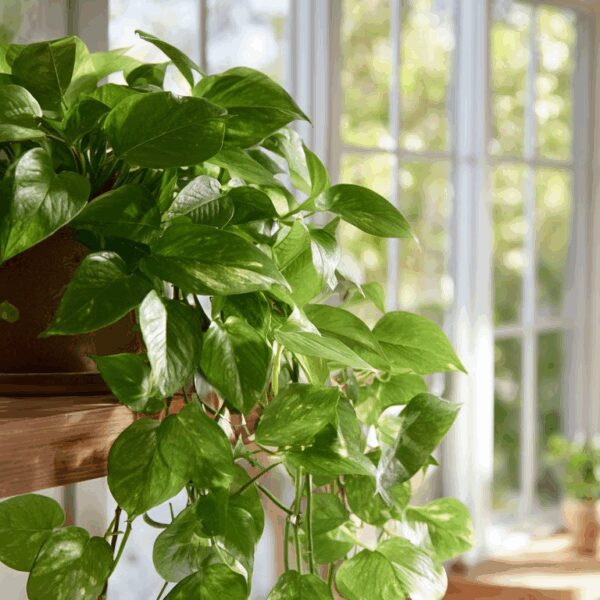If you’ve got a Fiddle Leaf Fig in your collection, you know they can be a bit dramatic. But here’s the deal: overwatering is often their biggest nemesis, especially as the weather cools down—so let’s make sure your leafy friend stays happy and healthy!
🌱 Green Thumb Essentials in 4 Points:
- Yellowing Leaves? That’s your Fiddle Leaf Fig’s way of saying, “Whoa, slow down on the water!” If you see those leaves turning yellow, especially from the bottom up, it’s time to check your watering routine. 🌿
- Leaf Drop Alert! If your plant is shedding leaves like it’s autumn outside, it might be drowning. Remember, a few leaves here and there are normal, but a sudden drop means you need to reassess. 🤔
- Soil Matters! Give your Fiddle Leaf Fig a mix that drains well—think perlite or orchid bark! Avoid regular garden soil; it holds too much moisture and can lead to trouble. 🌱
- Drainage is Key! Make sure your pot has holes. No holes? No problem! Just use a plastic nursery pot inside your decorative one. And don’t forget to dump out any standing water from the saucer after watering! 💧
Signs Your Fiddle Leaf Fig Is Getting Too Much Water
So, you’ve got a Fiddle Leaf Fig (Ficus lyrata) and you’re totally in love with it. But as the cooler fall weather rolls in, it’s easy to slip into bad watering habits. Overwatering is a common issue, and your plant can’t exactly tell you how it feels. Here are some telltale signs you should be on the lookout for.
Yellowing Leaves are often one of the first signs of overwatering. If you notice the leaves turning yellow, especially starting from the bottom and moving up, that’s a red flag. This could mean your plant is stressed and struggling to absorb water properly.
Leaf Drop is another major indicator. If you find leaves falling off unexpectedly, your Fiddle Leaf Fig might be drowning! Healthy plants will shed leaves occasionally, but if it’s happening a lot, take a closer look at your watering routine.
Understanding Your Plant’s Water Needs
It’s all about balance! Fiddle Leaf Figs like their soil to dry out somewhat between waterings. During fall, when light levels drop and temperatures cool down, these plants slow their growth. This means they need less water than they did during the summer months.
What Your Houseplants Need as the Days Get Shorter This Fall
A good rule of thumb? Stick your finger about an inch into the soil. If it feels dry at that depth, it’s time to water. If it’s still moist, wait a few more days. And remember, every home is different—factors like humidity and temperature can affect how quickly your soil dries out.
The Right Soil Makes All the Difference
Your choice of soil can also impact how much water your Fiddle Leaf Fig retains. A well-draining potting mix is crucial! Look for a mix designed for houseplants that includes components like perlite or orchid bark to help with drainage. Avoid regular garden soil, as it can hold onto too much moisture.
If you’ve repotted recently and aren’t sure about your mix, check its texture. It should be light and airy—if it feels dense or compacted, consider switching to a better mix next time you repot.
The Importance of Proper Drainage
And let’s not forget about drainage holes! Make sure your pot has good drainage; without it, excess water can build up at the bottom and lead to root rot. If you’ve got a beautiful decorative pot without holes, consider using a plastic nursery pot inside that can drain properly.
A saucer underneath can help catch excess water, but make sure to empty it out any time after watering to prevent standing water from causing problems.
Checking for Root Rot
If you suspect overwatering has already happened, it’s time for a little detective work. Gently pull your plant out of its pot and inspect the roots. Healthy roots should be white or light tan and feel firm to the touch. Dark brown or mushy roots? You’ve likely got root rot on your hands.
If this is the case, trim away any rotten parts with sterilized scissors and repot in fresh soil that drains well. Keep an eye on watering habits afterward—you don’t want to repeat this cycle!
Adjusting Your Watering Schedule
As we move deeper into October, adjust your watering schedule accordingly. With shorter days ahead and less sunlight hitting your fiddle leaf fig, less frequent watering will likely be needed compared to summer months.
Lastly, keep an eye on seasonal changes in humidity levels in your home; sometimes running heat during fall can dry things out faster than expected!







